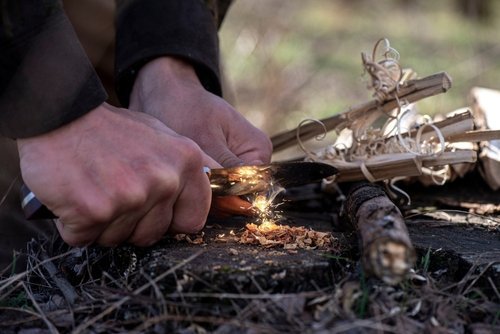
When it comes to starting a fire in the great outdoors, two tools have stood the test of time: flint and ferro rods. Both have their merits, but which one is superior? In this comprehensive guide, we’ll delve into the world of fire starting and help you decide whether flint or Ferro rod is the better choice for your survival and bushcraft needs. Whether you’re an outdoor enthusiast, a company specializing in outdoor gear, or a manufacturer looking to make the right product, we’ve got you covered. Join us as we explore the ins and outs of these firestarters and their suitability for various situations.
Understanding Flint and Ferro Rods

Historical Significance
Flint, a sedimentary rock composed of microcrystalline quartz, has a rich historical significance in fire starting. Dating back to ancient civilizations, flint was used to create sparks that ignited fires, providing warmth, light, and a means of cooking. Ferrocerium, the alloy commonly used in ferro rods, was developed more recently, primarily during the early 20th century. It revolutionized fire starting by offering a reliable and portable ignition source, making it a favorite among outdoors enthusiasts.
Components of Flint
Flint-based firestarters typically consist of two primary components:
- Flint Stone: The flint stone is the key component that produces sparks when struck with steel. It is a hard, durable material that can generate sparks at high temperatures.
- Steel Striker: The steel striker is a piece of high-carbon steel with a sharp edge. When scraped against the flint stone, it creates sparks through the process of rapid oxidation.
Components of Ferro Rods
Ferrocerium, commonly referred to as ferro rod or ferrocerium rod, is the primary component of ferro rod firestarters. It is a synthetic alloy composed of iron, cerium, lanthanum, and other elements. The key components include:
- Ferrocerium Rod: The main component, this rod is made of the ferrocerium alloy. When scraped with a hard object, it generates a large number of hot, burning metal shavings.
- Striking Tool: Users employ various striking tools, such as a dedicated ferro rod striker or a knife spine, to create the necessary friction and spark when striking the ferrocerium rod.
Mechanism of Ignition
Flint and Ferro‘s rods function on the principle of creating sparks through friction and rapid oxidation. When the steel striker is drawn against the flint stone, or when a hard object is scraped across the ferrocerium rod, friction generates intense heat. This heat ignites the tiny metal particles produced during the striking process, resulting in a shower of sparks. These sparks, burning at extremely high temperatures, can ignite readily available tinder or fuel, starting a fire.
Use in Survival and Bushcraft
Understanding the historical significance, components, and ignition mechanism of flint and ferro rods provides the foundation for their use in survival and bushcraft. These tools offer reliability, even in adverse conditions, making them valuable assets in scenarios where fire is crucial for warmth, cooking, signaling, and protection. Additionally, their compact size and durability make them indispensable for outdoor enthusiasts, preppers, and survivalists.
Advantages of Using Flint

Reliability in Harsh Conditions
One of the standout advantages of using flint for fire starting is its reliability in adverse conditions. Flint firestarters can produce sparks even in wet or windy environments. Unlike some modern alternatives, flint is not affected by moisture, ensuring consistent performance. This resilience makes Flint a go-to choice when venturing into unpredictable and challenging terrains where fire may be a lifeline.
Longevity and Durability
Flintstones are exceptionally durable and have a long lifespan. A single flint stone can last for an extended period, providing thousands of sparks before needing replacement. It’s an investment that can serve you well through multiple outdoor adventures without wearing out.
Compact and Lightweight
Flint fire starters are known for their compactness and lightweight design. They can easily fit into a pocket, backpack, or survival kit without adding significant bulk or weight. Flint’s compact nature ensures that you have a reliable fire-starting tool without sacrificing space or adding unnecessary weight to your gear.
Advantages of Using Ferro Rods

High-Temperature Sparks
Ferro rods are renowned for producing high-temperature sparks, often reaching temperatures of around 3,000°C (5,432°F). This extreme heat makes them highly effective for igniting various tinder materials, even in challenging conditions. The intense sparks can ignite dry leaves, grass, and other natural fire-starting materials quickly, reducing the effort required to build a fire.
Durability and Longevity
Ferro rods are built to last. They are known for their durability and long lifespan, capable of producing thousands of sparks over their lifetime. This longevity ensures that a single ferro rod can serve you through numerous outdoor adventures, making it a cost-effective choice in the long run.
All-Weather Performance
One of the standout advantages of ferro rods is their all-weather performance. They can generate sparks in wet, windy, and cold conditions, making them a reliable choice for survival situations where weather may be unpredictable.
Minimal Skill Required
Compared to some other fire-starting methods, using a ferro rod requires minimal skill. While it’s essential to practice and develop proficiency, Ferro rods are generally user-friendly. This makes them suitable for beginners or individuals who may not have extensive fire-starting experience. With the right tinder and technique, anyone can use a ferro rod effectively.
Comparing Flint and Ferro Rods

Ignition Method
- Flint: Flint operates by striking a piece of steel against the flint rock, creating sparks that ignite the tinder. This method relies on the hardness of the flint and the sharpness of the steel to produce sparks. While it can be effective, it may require more skill and practice to master the technique.How to Use Flint and Steel
- Ferro Rod: Ferro rods generate sparks by scraping a piece of steel (often referred to as a striker or scraper) against the rod’s ferrocerium material. This method produces high-temperature sparks consistently, making it easier to ignite various tinder materials. Ferro rods are known for their reliability and require less skill to use effectively.
Spark Temperature and Intensity
- Flint: The sparks produced by flint and steel are generally less intense and cooler in temperature compared to ferro rods. While they can ignite tinder, especially char cloth or charred materials, the lower temperature may require more effort and suitable tinder material.
- Ferro Rod: Ferro rods are known for their high-temperature sparks, reaching around 3,000°C (5,432°F). These intense sparks can ignite a wide range of tinder materials, including natural and synthetic options, with ease.
Durability and Longevity
- Flint: Flint rocks are relatively durable and can last for a long time, but the accompanying steel striker may wear out over extended use.
- Ferro Rod: Ferro rods are built to be highly durable and have a long lifespan. They can produce thousands of sparks, ensuring longevity and cost-effectiveness.
All-Weather Performance
- Flint: Flint and steel can be challenging to use in wet conditions, as moisture can hinder the production of sparks. It’s more suitable for dry weather or controlled environments.
- Ferro Rod: Ferro rods excel in all-weather performance. They can generate sparks even in wet, windy, or cold conditions, making them reliable tools for survival scenarios.

FAQ
Q1. Can I use flint and ferro rods interchangeably?
A1. While both flint and ferro rods serve the same fundamental purpose of igniting fires, they operate differently. Flint requires striking steel against the flint rock to create sparks, while ferro rods involve scraping steel against the rod’s ferrocerium material. Due to these differences in ignition methods, they are not entirely interchangeable. It’s essential to practice and become proficient with both tools if you plan to use them in various situations.
Q2. Can I use any steel as a striker for flint and steel firestarting?
A2. Ideally, the steel used as a striker should be hardened and capable of producing sparks when struck against flint. Traditional flint and steel kits often include a dedicated striker designed for this purpose. Using any random steel may not yield consistent sparks or may wear out quickly. It’s advisable to use a suitable striker designed for flint firestarting.
Q3. Are there specific tinder materials that work best with flint and ferro rods?
A3. Yes, some tinder materials are more suitable for use with flint and ferro rods. For flint and steel, char cloth and charred natural materials (such as fungus) are commonly used due to their low ignition temperature. Ferro rods, on the other hand, can ignite a broader range of tinder materials, including dry leaves, cotton balls, and synthetic fire starters. The key is to prepare your tinder materials appropriately to catch the sparks and ignite.
Conclusion
In the age-old debate of flint vs. ferro rod, the answer lies in the specific context and requirements of your outdoor adventures. Flint and steel offer a traditional and primitive method of firestarting, appealing to those seeking a deeper connection with ancestral skills. On the other hand, ferro rods bring modern reliability and versatility, making them highly effective in various weather conditions.
Ultimately, the choice between flint and ferro rod boils down to your preference, skill level, and the environments you frequent. Both tools have their merits and can be valuable additions to your outdoor gear arsenal. Whichever you choose, honing your firestarting skills is the key to success in the wild.

